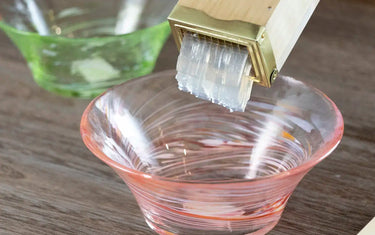The product we used:
What in samhill is tokoroten?

Tokoroten is a kind of gelatin made from red algae. Apparently, all you do is boil the algae and let the water set in a mold to create the gelatin.
Sounds weird

Yes, it's weird. Tokoroten, a mostly clear and flavorless block of jiggly water, is made from red algae.
But do you know what is even weirder? The gelatin in Jell-O is highly processed animal collagen. That's right, that fruity mass of childhood memories is made with beef knees and pork elbows.
Reality is stranger than fiction, friends.
Making Tokoroten


The tokoroten noodles pictured in this article are made using a tentsuki, or tokoroten cutter. Tokoroten is often extruded into noodles and topped with different sauces to add flavor.
Making the noodles is easy, but getting the algae (called tengusa) is hard. Tengusa is a specialty item even in Japan. But, we found some. We followed the included instructions for making tokoroten, boiling 50 grams of tengusa in around 2500cc of water for about 40 to 50 minutes until the algae "melts", strained the water to remove the remaining bits of algae, and then set it in the fridge to firm up.
Extruding the Noodles




After we had our gelatin, we cut it into bars that can fit into the tentsuki, load each block into the tentsuki, and then used the included tentsuki stick to push the gelatin through the tentsuki. The whole process was a very simple.
Kanten, a Tokoroten Substitute

If you're interested in making some tokoroten at home, but you don't have any luck procuring some tengusa, you can substitute agar powder to make kanten instead. Agar powder is derived from several sources, including tengusa. Most people making a vegetable-based gelatin in Japan make kanten rather than tokoroten simply because it's easier to come by.














